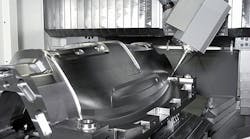New orders for machine tools and related technology dipped only slightly from September to October, falling 0.3% to $327.4 million, according to data reported by AMT – the Association for Manufacturing Technology in its latest U.S. Machine Tools Orders report. It was the second-consecutive monthly increase in order volumes, an encouraging detail in what has been a 15-month stall in overall growth for the manufacturing technology sector.
The October result is 28.3% lower than the October 2014 posting, and for the year-to-date the USMTO ($3.45 billion) shows a 17.4% decline in order volume versus the comparable 10-month period of 2014.
AMT’s monthly USMTO results are based on actual machine tool orders reported by participating companies who produce and distribute metal cutting and metal-forming and –fabricating equipment, including domestically manufactured and imported
machinery and equipment. While it is not reflective of manufacturing activity, as an indicator of capital investment it represents a gauge of manufacturers’ confidence in future activity.
“While the general economy continues to grow at a moderate pace, the manufacturing sector is struggling with the effects of a strong dollar, reduced commodity prices, especially oil, and struggles in key export markets like China,” commented AMT president Douglas K. Woods. “As the broader industry faces this slowdown, manufacturers are not making significant capital investment in new manufacturing technology.”
In its release, AMT noted that U.S. GDP is forecast to grow 2.4% in 2015, largely on the strength of consumer spending. “Economic data around manufacturing isn’t as positive,” the association averred, offering the contraction in the economy revealed in the Purchasing Managers Index in the October by the Institute for Supply Management.
“Additionally, the number of ‘net manufacturing jobs’ dropped by 1,000 while the larger economy added 211,000 jobs,” AMT added. “The ISM report and other indicators also show that manufacturers are working to reduce their excess inventory, meaning companies are concerned with the prospects for short-term future growth.”
“Market flatness can be expected to remain into 2016, and signs pointing to short-term interest rate hikes from the Federal Reserve could potentially hamper the consumer spending that is currently driving economic growth,” Woods cautioned.




